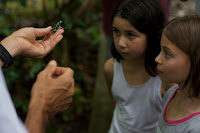Our group’s last couple of days in the Caribbean focused on the terrestrial side. Thursday we visited the most productive organic farm I’ve ever visited, Punta Mona. After college, I spent an idyllic few months as a volunteer at Punta Mona, helping the owner, Stephen Brooks, get the farm going with a group of friends. That time ignited an interest in sustainable agriculture that continues today as I work to turn my entire yard into a garden.
In the ten years since I worked at Punta Mona, the place has gone from a fairly productive farm with 20 or so varieties of food to a super-productive farm with more than 200 species of fruit trees alone. Literally everything growing in this place has some sort of value, whether medicinal, nutritional, spiritual, or cultural. Our group has never tasted, smelled, or adorned ourselves with so many natural items in one short span. Our tour guide, Richard, the farm manager, overwhelmed every one of our senses on this hike.
Stephen is one of the most interesting characters you will ever meet. In addition to founding the farm years ago, he also started a student ecotravel company called Costa Rican Adventures (now sold to others and with whom I did my first tour guiding) and more recently started an organic food company called Kopali Organics. Look for them at natural food stores (I recommend the chocolate covered Gogi berries). His passion for sustainability and plants is contagious and his vision is inspiring.
The next morning, we met Tino, in my opinion Costa Rica’s best nature guide, despite the hard time he gives me every time we go into the forest with a group. He took us into the Gandoca-Manzanillo Wildlife Refuge, an incredible piece of land at the very southernmost point along the Caribbean coast, which he helped to create about 20 years ago. In a relatively short hike, he showed us 5 sloths, several howler monkeys, four snakes, dozens of interesting trees and plants, and more. Its no wonder he was mentioned by name in a recent New York Times article about the region.
Earlier, while visiting the community of Soki in the Bribri Indigenous Reserve, I spoke with one of our hosts who works with a local cooperative called APPTA (Association of Small Producers of Talamanca) that he worked with to sell his organic cacao beans and bananas. I had heard of APPTA’s work in the region and put in a call to a contact I had made years before about touring their cacao processing plant, which we did after the nature hike.
There, our host Walter Rodriguez, told us how the cacao produced in this region was developing a reputation as one of the best in the world; a recent shipment was sent to the high end chocolate company Theo in Seattle. We toured their facility, where they ferment and dry the beans for exportation. He also showed us a nursery where they are cultivating more productive trees for members of the cooperative.
Walter told us of meeting an indigenous man years before while working with Asociacion ANAI, a regional conservation organization who also originally started the turtle project in Gandoca. This man walked 7 hours round trip to deliver a few pounds of cacao seeds to a store and received enough money for 2 bags of salt in exchange. Walter realized that cacao could be a way to help these forgotten communities out of poverty and helped to create APPTA. Now, according to Walter, APPTA has more than 1,200 members in 40 indigenous communities around the region, who make their living producing organic foods such as cacao, bananas, and other fruits. Their entire production of cacao is spoken for; in fact they could increase their production ten-fold and still not have any left over. The new trees they are producing are about 30 times more productive, which is good news for chocolate lovers everywhere!
Anyone needing to see some good news in the world after the oil spill should take a visit to this region to see (and smell and taste) what progress can be made when dedicated people work towards protecting wildlife and communities. Even though I’ve spent a lot of time in this area over the past decade, every visit brings new experiences and new inspiration to continue working to support our friends in Costa Rica. We hope to show you these incredible places on our next trip!
-Brad Nahill
PS- More and better pictures to be posted soon!




